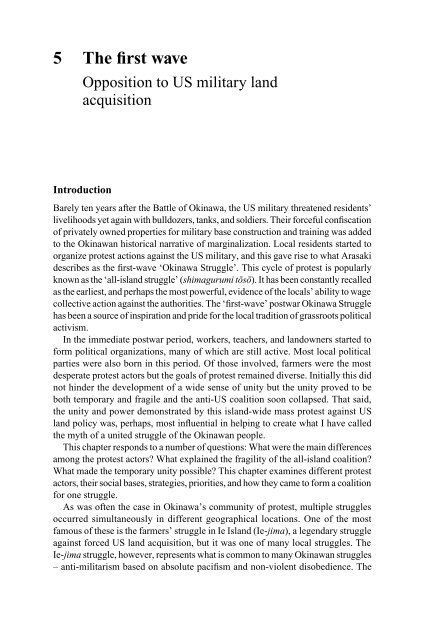Myth, Protest and Struggle in Okinawa
Myth, Protest and Struggle in Okinawa
Myth, Protest and Struggle in Okinawa
You also want an ePaper? Increase the reach of your titles
YUMPU automatically turns print PDFs into web optimized ePapers that Google loves.
5 The first wave<br />
Opposition to US military l<strong>and</strong><br />
acquisition<br />
Introduction<br />
Barely ten years after the Battle of Ok<strong>in</strong>awa, the US military threatened residents’<br />
livelihoods yet aga<strong>in</strong> with bulldozers, tanks, <strong>and</strong> soldiers. Their forceful confiscation<br />
of privately owned properties for military base construction <strong>and</strong> tra<strong>in</strong><strong>in</strong>g was added<br />
to the Ok<strong>in</strong>awan historical narrative of marg<strong>in</strong>alization. Local residents started to<br />
organize protest actions aga<strong>in</strong>st the US military, <strong>and</strong> this gave rise to what Arasaki<br />
describes as the first-wave ‘Ok<strong>in</strong>awa <strong>Struggle</strong>’. This cycle of protest is popularly<br />
known as the ‘all-isl<strong>and</strong> struggle’ (shimagurumi tōsō). It has been constantly recalled<br />
as the earliest, <strong>and</strong> perhaps the most powerful, evidence of the locals’ ability to wage<br />
collective action aga<strong>in</strong>st the authorities. The ‘first-wave’ postwar Ok<strong>in</strong>awa <strong>Struggle</strong><br />
has been a source of <strong>in</strong>spiration <strong>and</strong> pride for the local tradition of grassroots political<br />
activism.<br />
In the immediate postwar period, workers, teachers, <strong>and</strong> l<strong>and</strong>owners started to<br />
form political organizations, many of which are still active. Most local political<br />
parties were also born <strong>in</strong> this period. Of those <strong>in</strong>volved, farmers were the most<br />
desperate protest actors but the goals of protest rema<strong>in</strong>ed diverse. Initially this did<br />
not h<strong>in</strong>der the development of a wide sense of unity but the unity proved to be<br />
both temporary <strong>and</strong> fragile <strong>and</strong> the anti-US coalition soon collapsed. That said,<br />
the unity <strong>and</strong> power demonstrated by this isl<strong>and</strong>-wide mass protest aga<strong>in</strong>st US<br />
l<strong>and</strong> policy was, perhaps, most <strong>in</strong>fluential <strong>in</strong> help<strong>in</strong>g to create what I have called<br />
the myth of a united struggle of the Ok<strong>in</strong>awan people.<br />
This chapter responds to a number of questions: What were the ma<strong>in</strong> differences<br />
among the protest actors? What expla<strong>in</strong>ed the fragility of the all-isl<strong>and</strong> coalition?<br />
What made the temporary unity possible? This chapter exam<strong>in</strong>es different protest<br />
actors, their social bases, strategies, priorities, <strong>and</strong> how they came to form a coalition<br />
for one struggle.<br />
As was often the case <strong>in</strong> Ok<strong>in</strong>awa’s community of protest, multiple struggles<br />
occurred simultaneously <strong>in</strong> different geographical locations. One of the most<br />
famous of these is the farmers’ struggle <strong>in</strong> Ie Isl<strong>and</strong> (Ie-jima), a legendary struggle<br />
aga<strong>in</strong>st forced US l<strong>and</strong> acquisition, but it was one of many local struggles. The<br />
Ie-jima struggle, however, represents what is common to many Ok<strong>in</strong>awan struggles<br />
– anti-militarism based on absolute pacifism <strong>and</strong> non-violent disobedience. The
















